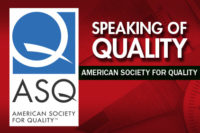Yes, it’s true that teams can be ineffective, time-sucking entities. But they don’t have to be that way. Well-run teams are creative, innovative and effective. These teams improve processes, save money and delight customers (internal and external).
It’s time to toot some horns.
Since 1985, the International Team Excellence Award Process has been showcasing the results of teams eager to share their success stories with the quality community. Since the inception of the program, over 1,100 teams from 23 countries have participated in this unique process.
ASQ has been a proud administrator of the process since 2003. The team finalists present their stories each year at ASQ’s World Conference on Quality and Improvement. What makes this award process special is that teams are not evaluated simply on who saved the most money or what team gave the most entertaining presentation. Each team is judged on a robust criteria developed specifically for determining the effectiveness of the team and its use of quality methodology. Teams—regardless of whether they apply to be a finalist—can benefit from adopting the criteria. The ITEA criteria are project- and team-centric, detailing what a team needs to do to become a high-performing team.
Teams are judged on the following criteria:
Project and team selection
Current situation and root cause/improvement opportunity analysis
Solution/Improvement development
Implementation and results verification
Sustaining and communicating results
Overall presentation
It is a rigorous process, for both teams and judges, but one that is completed with enthusiasm and a sense of accomplishment. Over the past few years, conference attendees have eagerly filled many of the presentations to capacity—getting the opportunity to hear about the quality journey directly from the team members who lived through it all.
But the sharing does not end at the World Conference. Presentations of all the International Team Excellence Award Process finalists are made available to the public. Here is a list of brief descriptions for three of the 2014 finalists. (Download the presentations at http://asq.org/wcqi/team-award/case-studies-2014.aspx.)
Avea Iletisim Hizmetleri A.S.; BaSIC; Istanbul, Turkey
This project aimed to improve the BSC/RNC rollout process. BSCs and RNCs are the central units that link base stations to the core GSM network. Using DMAIC methodology and the Lean Six Sigma approach, the team employed quality tools like Pareto, boxplot, fishbone, multivoting, and cause and effect diagram. With the implementation, the process was improved at the rate of about 75%. The project brought an annual OPEX savings of $547,000 by minimizing deviations and standardizing the rollout period.
Nexteer Automotive; Ball Nut 1 Rev;
El Marques, Queretaro, Mexico
This project focused on eliminating a failure mode called ball nut 1/rev by using the fast x methodology. The team utilized statistical tools such as correlation plots, part swap, multivary, two-sample t-test, and DoE to get statistically based conclusions. The project results included an improved scrap cost of $12.5/piece, 95% production compliance to schedule, and US$400,000 in annual savings.
Tetra Pak Packaging Solutions;
Science and Engineering Capability Team; Lund, Skane, Sweden
This project focused on developing engineering capabilities within Tetra Pak. A capability is the integration of people’s competences and their processes, methods and tools. Following change management principles and the steps of a business transformation process, the team shared knowledge and experiences across units, built on existing capabilities, and developed new ones. The project resulted in a 30% increased score in measurements of engineering capabilities and a visible change in the way the team works.
Many companies send teams back year after year, stressing not only a commitment to teams but that a team culture is sustainable over time, departments and management.
If you scoff at the idea that cross-functional teams are productive, you need to get to the International Team Excellence Award web page and read a few project presentations. Customer satisfaction, innovation, profitability, increased employee motivation, and teamwork are all results that will get the attention of any CEO.
The horns can be heard around the world.


